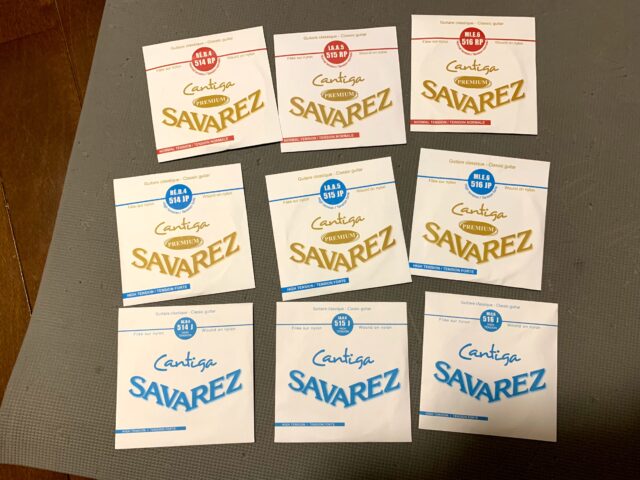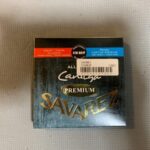I purchased Cantiga Premium, a new Savarez product that was released in November 2018.
I will review it as soon as possible.

The following article summarizes the string reviews/impressions/information articles in this blog

- Bass strings with new windings.
- The packaging is gorgeous, but as usual, no airtight packaging.
- I can’t really tell the difference in appearance.
- The premium one feels a little harder to the touch.
- Gorgeous bass, like Augustine blue.
- Tension is strong.
- Longevity with a reputation among professionals
- summary
Bass strings with new windings.
First of all, let’s review the Cantiga Premium, which is an improved version of the Cantiga winding that is often used by professionals.
Cantiga themselves are only available with bass strings, so Cantiga Premium is also only available with bass strings.
Three types of treble strings are available as a set, combining New Crystal and Alliance.
The official website of Savarez touts its long life, and the Japanese distributor seems to promote its massive sound.
See this article for details:

The packaging is gorgeous, but as usual, no airtight packaging.

Here is the package. This time I bought only the bass strings. I bought Cantiga Premium normal tension and high tension. The bottom one is the normal Cantiga high tension.
As you can see, the letters are written in gold, which is gorgeous compared to the normal model with one color printing.
However, the strings are still naked in the paper package, not in the airtight package that is done with Augustine and Pro Arte.
Maybe it’s a sign of confidence that they won’t rust easily, but…. It is true that I have never had any rusting before using it.
If you are concerned about it, you might want to store it like this:


Here is the back of the package. This is the back of the package. It is multi-colored and has the French flag printed in color.
I can’t really tell the difference in appearance.
I immediately opened the inside.
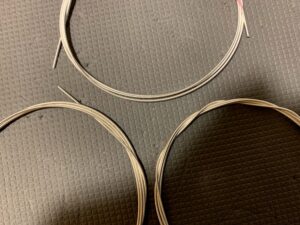
They are all six-stringed. Can you tell which one is which?
The correct answer is.
- Above is the normal Cantiga Premium.
- Bottom left is the Cantiga Premium high.
- Bottom right is Cantiga’s high.
It is.
You can barely tell if it’s normal or high by its thickness, but you can’t tell if it’s premium or not from its appearance.
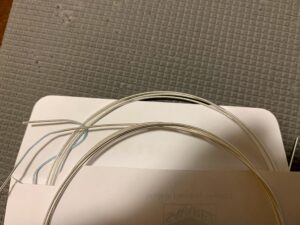
This is the fourth string. The end treatment is the same, so I’m not sure I can guess which one is which.
The premium one feels a little harder to the touch.
On the other hand, when I touch it or bend it, I somehow feel that the Premium is a little stiffer.
Since the core wire is the same Cantiga core, is there a difference in the characteristics of the windings?
This hardness may be the reason for the heaviness.
Gorgeous bass, like Augustine blue.
Finally, I was able to put up the high tension one.
- New crystal (high) on strings 1 and 2
- Third string is Cantiga (high)
- Cantiga premium (high) on strings 4-6
So it’s a high-tension set (510MJP) of Creation Cantiga Premium.
The first thing I noticed when I was stringing it was that the strings were stiff.
The regular Cantiga are rather pliable, and when strung, they bend so well that it is hard to believe that they are wound strings, but the premium ones are firm like old-fashioned bass strings.
Perhaps this is why the sound is so massive and brilliant. The Cantiga was characterized by a well-balanced and thick sound, rather than a heavy and brilliant sound. The Premium seems to have more brightness and volume. I imagine it as an Augustinian blue without the roughness.
I’m looking forward to seeing how it goes from here since it’s still freshly strung. The Cantiga sounded clearer after a little while than right after I stretched it, so I hope the weight and brightness will settle down in a good way.
(P.S.): The sparkle, or rather the glare, settled down after a day or two. It has a nice shine and a massive sound, but is also easy to control.
Tension is strong.
On the other hand, the tension is a bit strong, as evidenced by the hard feel of the strings.
It’s not that it’s completely unreliable, but if you play it with the same feeling as a normal Cantiga, you may feel uncomfortable.
Well, I suppose it’s inevitable, since it’s so massive.
Longevity with a reputation among professionals
It’s been about a week since I put it up, and so far I haven’t gotten the impression that it has deteriorated since the sound settled down.
It seems to have a good reputation among professionals, and many positive comments about its longevity have been posted on Twitter and other media, such as “the bass strings used to wear out after one concert, but now they are fine even after multiple concerts.
It’s been about three weeks since I put it up, and it certainly seems to have a long life. The brilliance of the sound is gradually disappearing, but the core of the sound is still there.
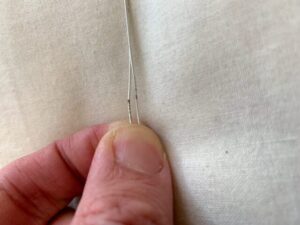
It’s hard to tell from the pictures, but on the left is a regular Cantiga and on the right is a Cantiga Premium. Both are 3 weeks old, but the Cantiga has lost its coating and the copper color is showing, while the Premium has not exposed the copper inside. It seems to be physically durable.
summary
My impression right after I put it up was that it sounded different from a normal Cantiga in a good way, which was interesting.
The price is +290 yen compared to the regular Cantiga, so if it has a long life as advertised, I think it’s a good deal.
